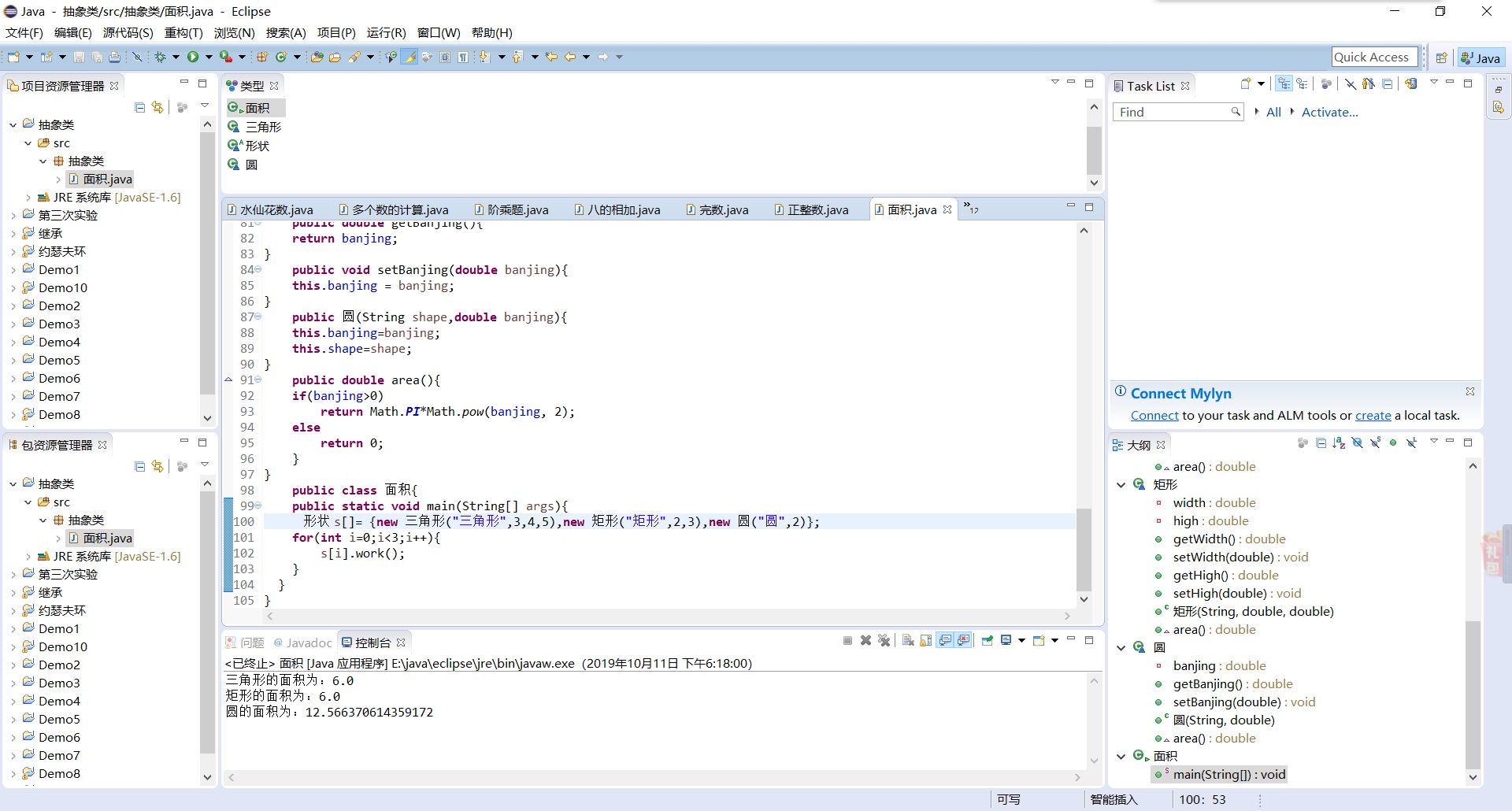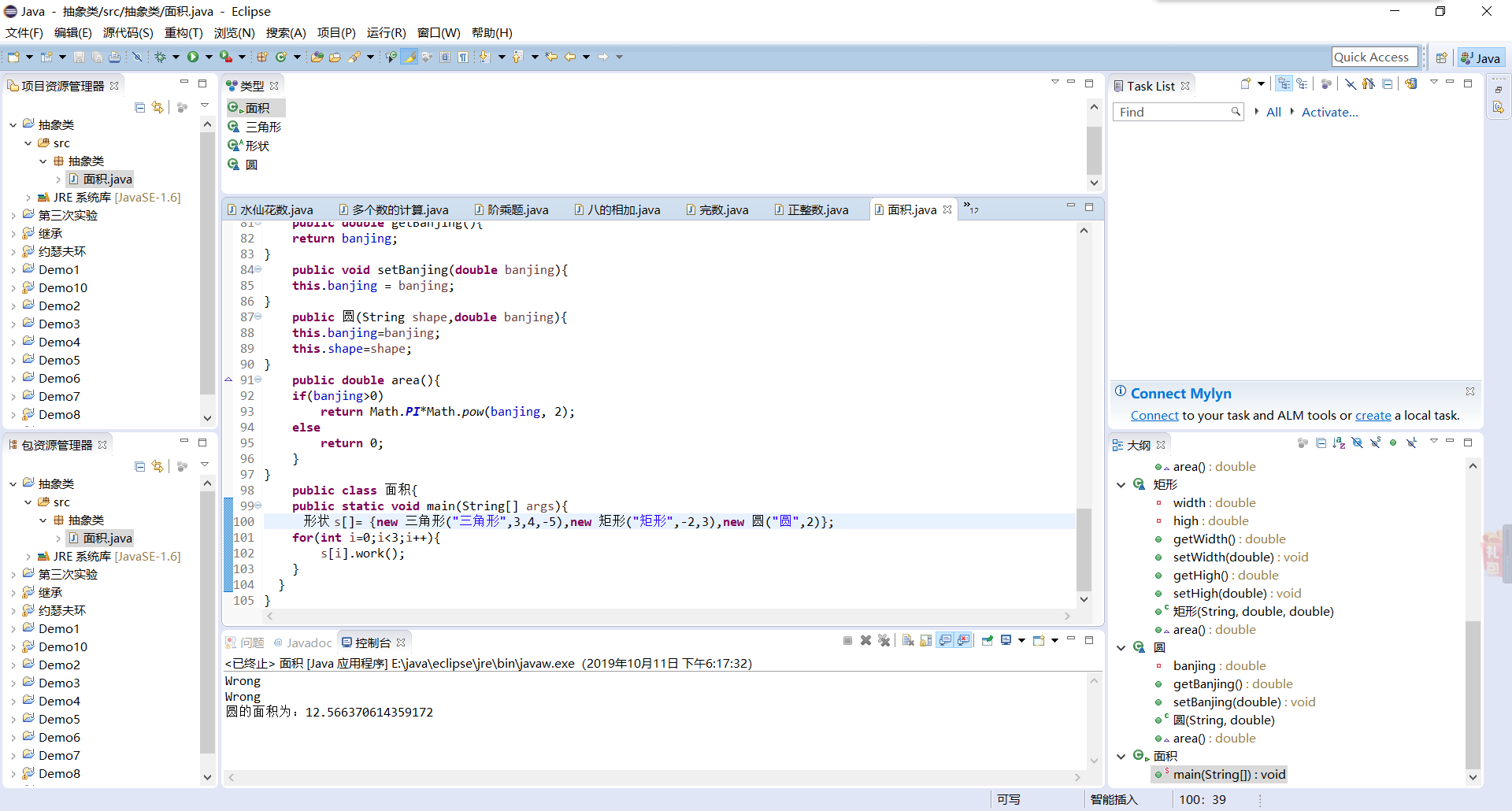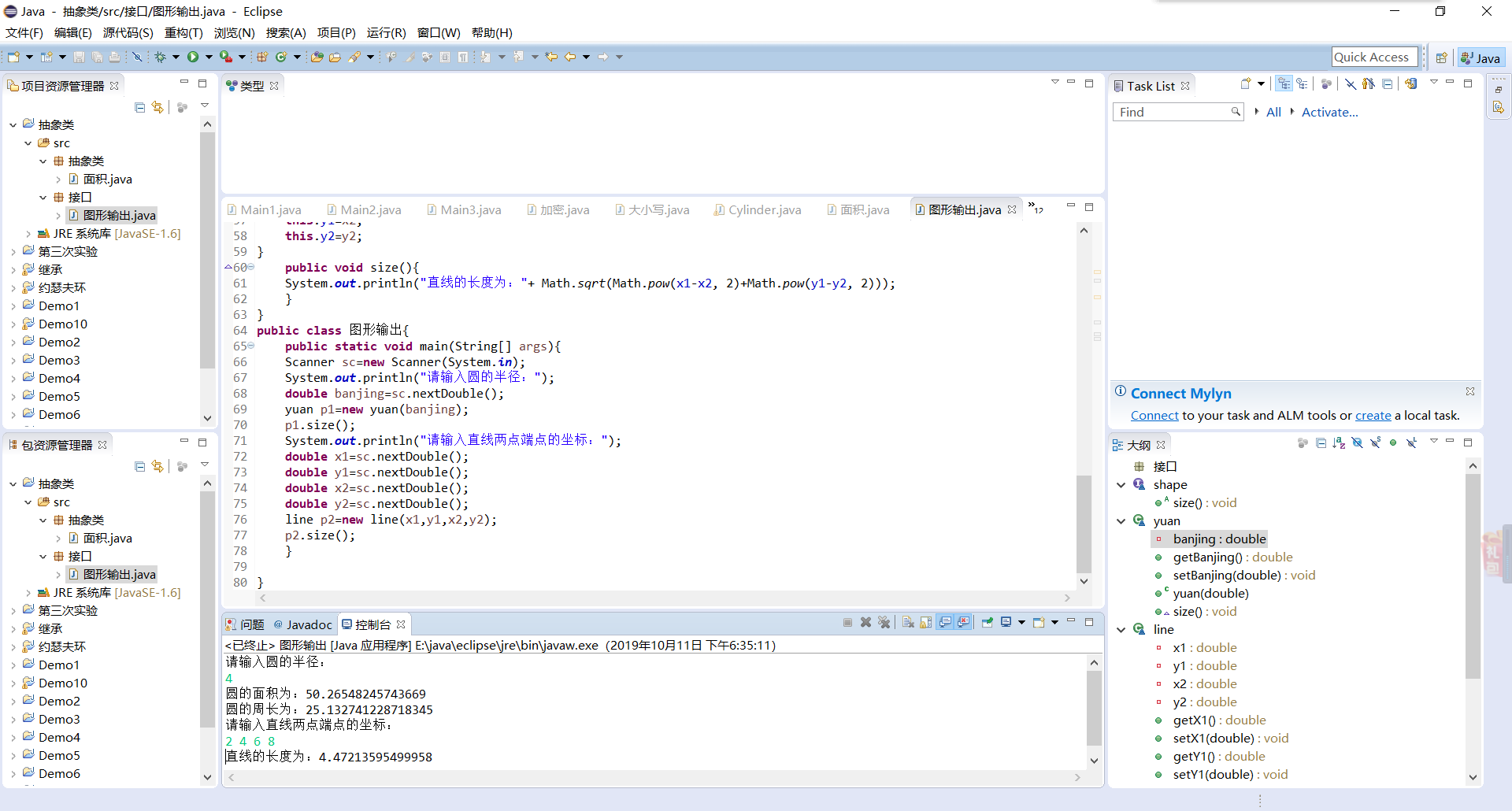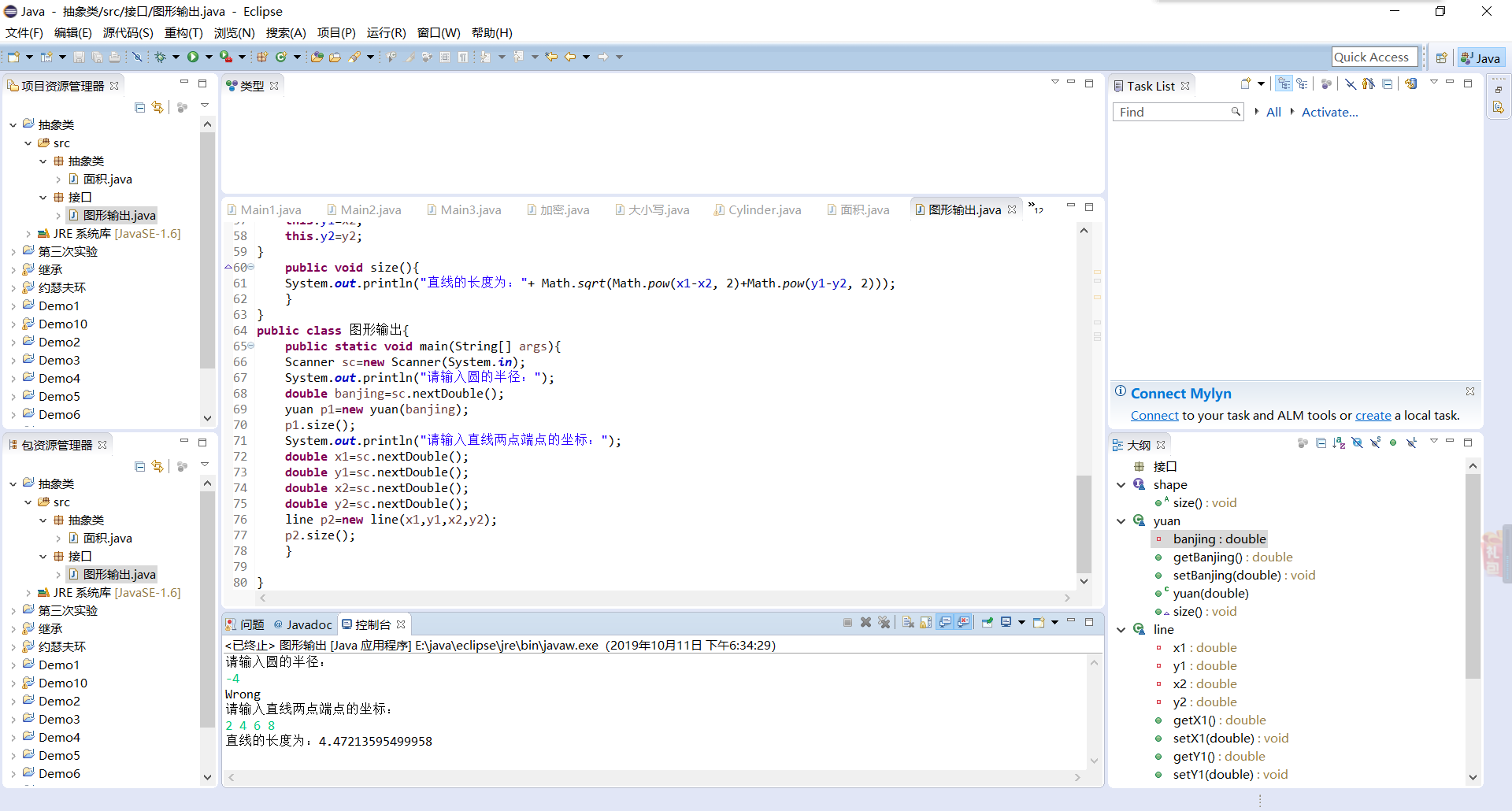一、实验目的
(1)理解抽象类与接口的使用;
(2)了解包的作用,掌握包的设计方法。
二、实验要求
(1)掌握使用抽象类的方法。
(2)掌握使用系统接口的技术和创建自定义接口的方法。
(3)了解 Java 系统包的结构。
(4)掌握创建自定义包的方法。
三、实验内容
(一)抽象类的使用
设计一个类层次,定义一个抽象类--形状,其中包括有求形状的面积的抽象方法。 继承该抽象类定义三角型、矩形、圆。 分别创建一个三角形、矩形、圆存对象,将各类图形的面积输出。
注:三角形面积s=sqrt(p(p-a)(p-b)*(p-c)) 其中,a,b,c为三条边,p=(a+b+c)/2
2.编程技巧
(1) 抽象类定义的方法在具体类要实现;
(2) 使用抽象类的引用变量可引用子类的对象;
(3) 通过父类引用子类对象,通过该引用访问对象方法时实际用的是子类的方法。可将所有对象存入到父类定义的数组中。
(二)使用接口技术
1定义接口Shape,其中包括一个方法size(),设计“直线”、“圆”、类实现Shape接口。分别创建一个“直线”、“圆”对象,将各类图形的大小输出。
2.编程技巧
(1) 接口中定义的方法在实现接口的具体类中要重写实现;
(2) 利用接口类型的变量可引用实现该接口的类创建的对象。
1.实验代码
package 抽象类;
abstract class 形状{
public String shape;
public double area;
public String getShape(){
return shape;
}
public void setShape(String shape){
this.shape=shape;
}
public double getArea(){
return area;
}
public void setArea(double area){
this.area = area;
}
public void work(){
if(this.area()!=0)
System.out.println(this.shape+"的面积为:"+this.area());
else
System.out.println("Wrong");
}
public abstract double area();
}
class 三角形 extends 形状{
private double a,b,c;
public double getA() {
return a;
}
public double getB() {
return b;
}
public double getC() {
return c;
}
public 三角形(String shape,double a,double b,double c){
this.a=a;
this.b=b;
this.c=c;
this.shape=shape;
}
public double area(){
if(a+b>c&&a+c>b&&b+c>a&&a>0&&b>0&&c>0){
double p=(a+b+c)/2;
return Math.sqrt((p*(p-a)*(p-b)*(p-c)));
}
else
return 0;
}
}
class 矩形 extends 形状{
private double width,high;
public double getWidth(){
return width;
}
public void setWidth(double width){
this.width = width;
}
public double getHigh(){
return high;
}
public void setHigh(double high){
this.high = high;
}
public 矩形(String shape,double width,double high){
this.high=high;
this.width=width;
this.shape=shape;
}
public double area(){
if(high>0&&width>0)
return high*width;
else
return 0;
}
}
class 圆 extends 形状{
private double banjing;
public double getBanjing(){
return banjing;
}
public void setBanjing(double banjing){
this.banjing = banjing;
}
public 圆(String shape,double banjing){
this.banjing=banjing;
this.shape=shape;
}
public double area(){
if(banjing>0)
return Math.PI*Math.pow(banjing, 2);
else
return 0;
}
}
public class 面积{
public static void main(String[] args){
形状 s[]= {new 三角形("三角形",3,4,5),new 矩形("矩形",2,3),new 圆("圆",2)};
for(int i=0;i<3;i++){
s[i].work();
}
}
}
实验结果
正确结果:
数据错误时:
2.实验代码
package 接口;
import java.util.Scanner;
interface shape{
public void size();
}
class yuan implements shape{
private double banjing;
public double getBanjing(){
return banjing;
}
public void setBanjing(double banjing){
this.banjing=banjing;
}
public yuan(double banjing){
setBanjing(banjing);
}
public void size(){
if(banjing<=0)
System.out.println("Wrong");
else{
System.out.println("圆的面积为:"+ Math.PI*Math.pow(banjing, 2));
System.out.println("圆的周长为:"+ Math.PI*2*banjing);
}
}
}
class line implements shape{
private double x1,y1,x2,y2;
public double getX1(){
return x1;
}
public void setX1(double x1){
this.x1 = x1;
}
public double getY1(){
return y1;
}
public void setY1(double y1){
this.y1 = y1;
}
public double getX2(){
return x2;
}
public void setX2(double x2){
this.x2 = x2;
}
public double getY2(){
return y2;
}
public void setY2(double y2){
this.y2 = y2;
}
public line(double x1,double y1,double x2,double y2){
this.x1=x1;
this.x2=x2;
this.y1=x2;
this.y2=y2;
}
public void size(){
System.out.println("直线的长度为:"+ Math.sqrt(Math.pow(x1-x2, 2)+Math.pow(y1-y2, 2)));
}
}
public class 图形输出{
public static void main(String[] args){
Scanner sc=new Scanner(System.in);
System.out.println("请输入圆的半径:");
double banjing=sc.nextDouble();
yuan p1=new yuan(banjing);
p1.size();
System.out.println("请输入直线两点端点的坐标:");
double x1=sc.nextDouble();
double y1=sc.nextDouble();
double x2=sc.nextDouble();
double y2=sc.nextDouble();
line p2=new line(x1,y1,x2,y2);
p2.size();
}
}
实验结果
正确结果:
数据错误是:
学习总结
(1)instanceof关键字
Java中的一个双目运算符,用来测试一个对象是否为一个类的实例,用法为:boolean result = obj instanceof Class;
注意事项:编译器会检查 obj 是否能转换成右边的class类型,如果不能转换则直接报错,如果不能确定类型,则通过编译。
(2)抽象类与接口的关系

这一点知识是在网上寻找的,上节课为了赶上拿错了数据结构的书,而且坐在太后面看不太清,故上网查询。